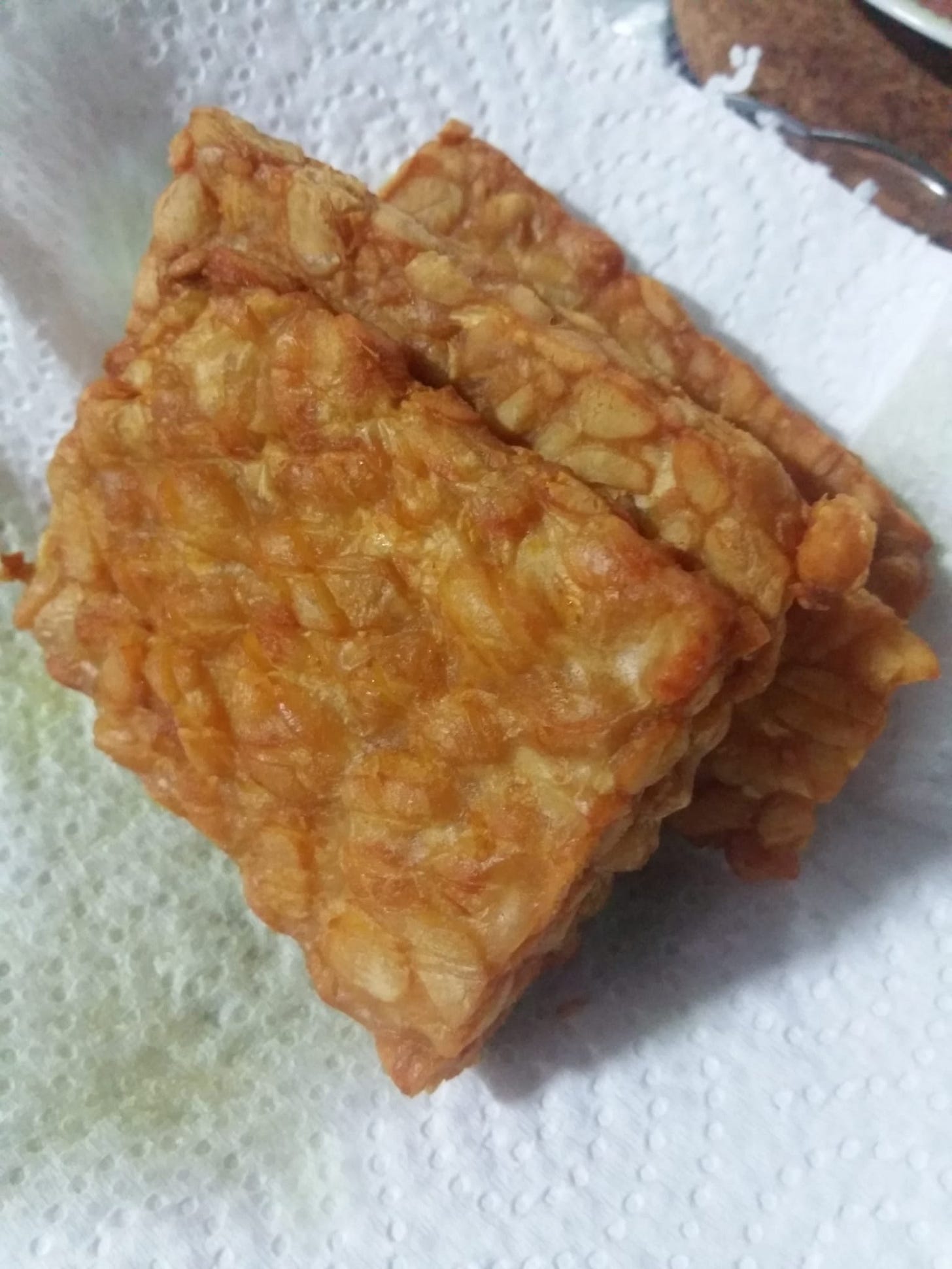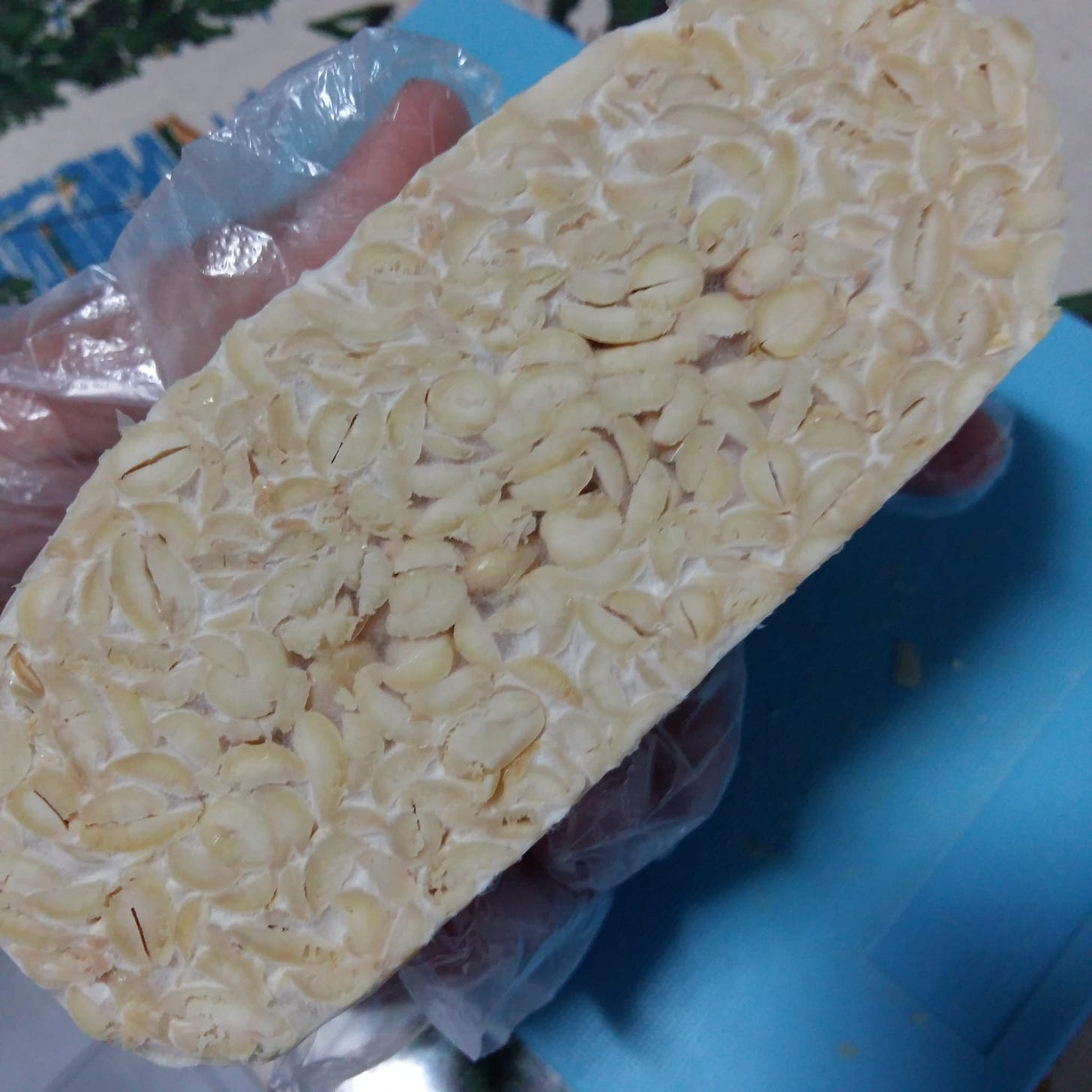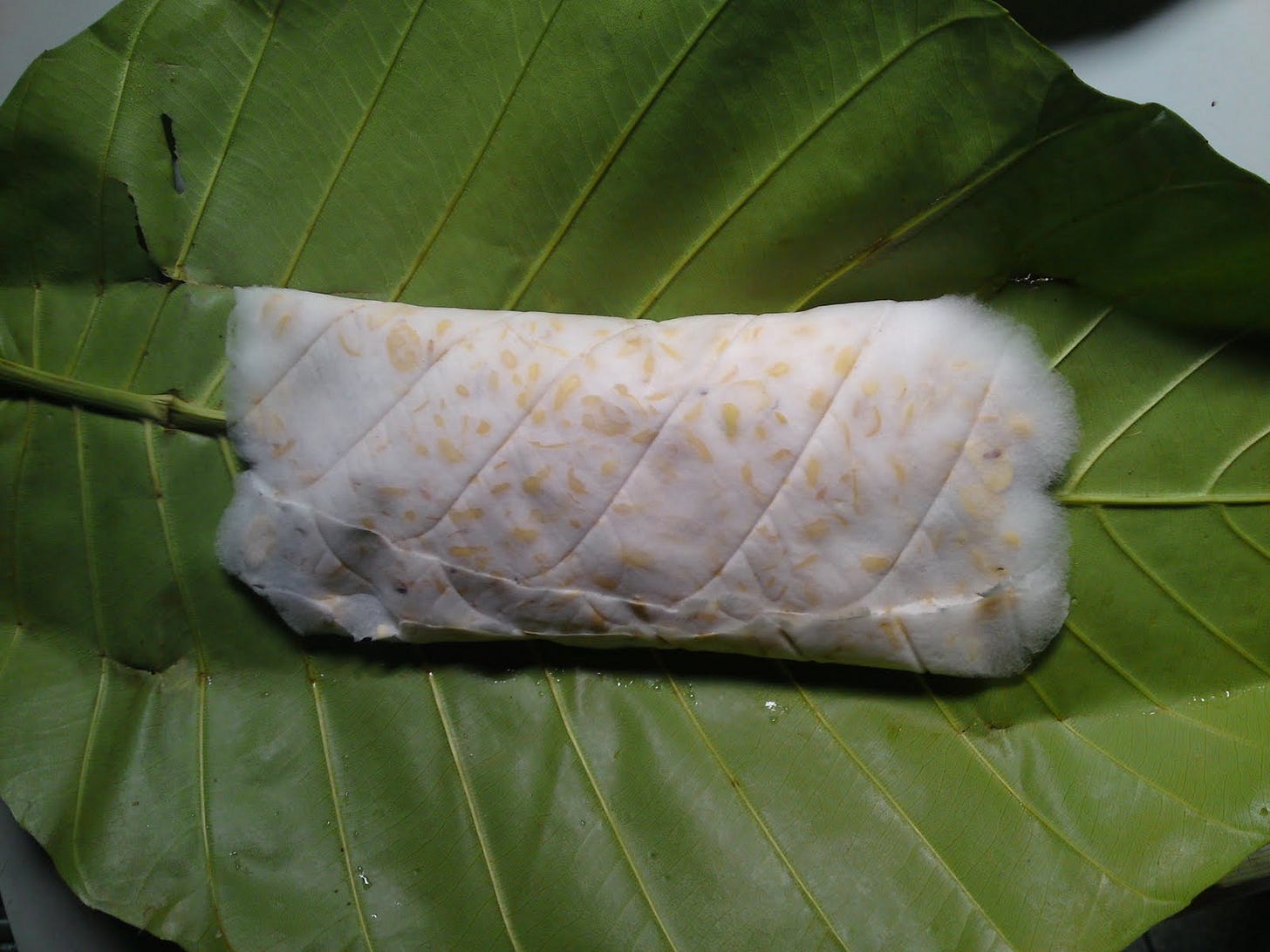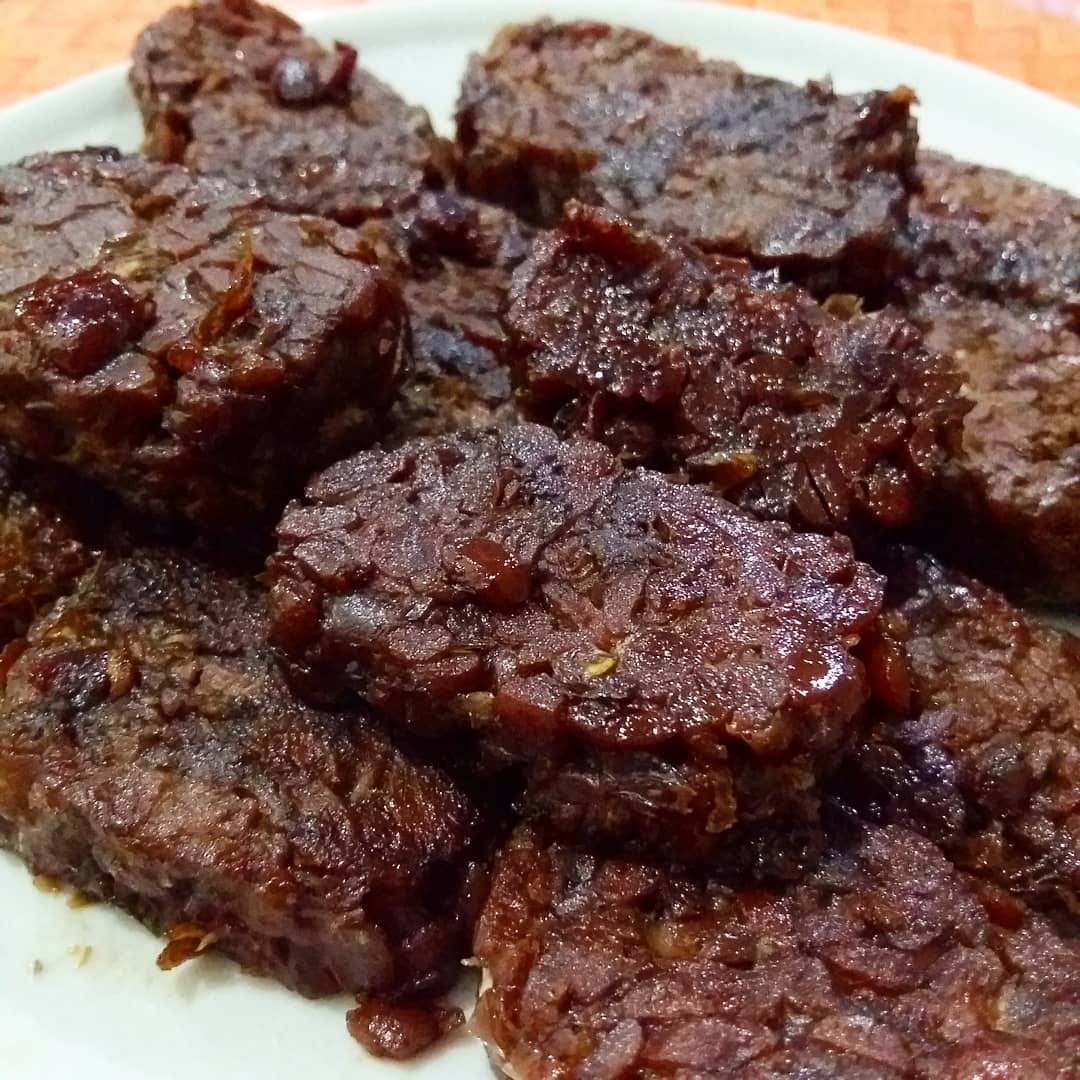While working on Seasonings Magazine’s Hari Raya Puasa edition earlier this year, I learnt that one of our contributors, Hairil Sukaime (Instagram/ website), has tempeh artisans for grandparents. That fascinated me because tempeh is something that is so often made by big companies in factories. I never knew that we have/ had our very own tempeh makers in Singapore! Speaking to Hairil was such a treat and I hope you’ll enjoy the following conversation.
Hairil, thank you so much for speaking with me. Could you tell me about your family’s relationship with tempeh?
Being of Javanese descent, tempeh-making, consumption, and appreciation is in my family's blood. My dad's side of the family had been making tempeh from their home in the aptly-named Kampung Tempeh even before I was born, and the tradition continued even after the families were relocated to HDB flats in the mid to late 1980s. In the late 1990s to early 2000s, due to old age and health issues, my extended family's home-based tempeh-making trade ceased.
Although I can't recall the exact moment I was introduced to tempeh, it has always been a part of our family meals and gatherings. It was not uncommon to see large quantities of raw and cooked soya beans, as well as huge piles of homemade tempeh in the kitchens of two of my aunts on a regular basis. It definitely isn't an exaggeration when I say that my dad, his 8 siblings, and a significant number of other family members were literally and figuratively brought up with (and thanks to) tempeh.

Where is Kampung Tempeh in modern-day Singapore, and why was it named so?
It was located around present-day Jalan Haji Alias; off Sixth Avenue in Bukit Timah. With the exception of a small group of Chinese families, almost all families living there were of Javanese descent and made tempeh for a living; hence its name. At one time, it was believed to have been Singapore's largest producer of tempeh.
The area that the Kampung once sat on has been redeveloped and now houses swathes of multimillion-dollar bungalows. As far as I know, the only remnants of the Kampung still standing today are two places of worship - Al Huda Mosque and Hoon San Temple. My dad and his brother would enthusiastically point out landmarks of the past (such as the former sites of a provision shop and of neighbours houses) whenever we visit the area during Hari Raya prayers at the mosque.
Have you ever tried making your own tempeh?
I dabbled in making tempeh at home in 2018, after reading up on it and visiting places and people in Indonesia that specialized in tempeh. Due to space constraints in my home kitchen, it was definitely a challenge. The process involved a lot of water, soya beans, patience, and elbow grease! But seeing the tempeh develop its signature white mycelium fungus as part of the tempeh-making process and tasting the resulting product is very rewarding and fulfilling!

How does your family’s tempeh taste, compared to commercial tempeh?
I may be biased, but homemade tempeh tastes so much better; things made in smaller batches tend to have more "soul". While I cannot recall the exact flavour of the tempeh that my late grandmother and aunts used to make, the fact that they did it for decades is a reflection of quality (similar to the likes of long-lasting hawkers and eateries).
Commercially-made tempeh tend to suffer from an issue known as "patah pinggang" (lit. broken hip), where the mycelium fails to properly form and results in faster spoilage (i.e. mushy/slimy tempeh, pungent and unpleasant odour). It could possibly be due to the fact that the tempeh wasn't allowed to ferment in the right conditions (i.e. not given enough space and/or air to "breathe").

Are there any differences between traditional tempeh-making and how it is made today/ by big manufacturers?
In the past, tempeh-making was a largely manual operation with very little to no mechanical equipment use. Soya beans were dehulled by being stepped on (similar to how wine grapes were being processed in the past). Next, the cooked and cooled beans are rubbed against waru (hibiscus tiliaceus) and jati (teak) leaves before being packed. Obtaining the culture for making tempeh from the undersides of these leaves was traditional; the rubbing of the beans against the leaves acts as a process of inoculation known as usar, which loosely translates to ‘rub’ or ‘rubbing’.
In addition to using scraps of older tempeh as a starter culture, used leaves from previous batches of tempeh can also be used to "catch" the remnants of the culture.
Leaves are traditionally used to wrap tempeh because they are naturally porous, and this circulation of air is one of the key factors that affects the fermentation process. The leaves of the simpoh air plant (dillenia suffruticosa) has been used by tempeh makers in Singapore due to its abundance, and able-bodied male residents of the kampung were typically tasked with collecting the leaves from nearby forests for tempeh-making.
The resulting tempeh often has a pleasant imprint/pattern courtesy of the veins of the leaves. I've also read that rojak and some rice dishes were wrapped in simpoh air leaves for takeaway, before the use of the now-ubiquitous brown takeaway paper commonly used by hawkers and other eateries.
Most tempeh manufacturers these days use commercially-produced tempeh starters (rhizopus oligosporus) and equipment, such as soya bean dehulling machines and automated tempeh-packing machines. Also, perforated plastic and biodegradable packaging are used in modern-day tempeh-making mainly due to convenience. I've also come across tempeh that has been fermented in cake moulds and muffin tins!

Is plant-based eating part of traditional Malay food culture, and how does tempeh fit into that picture?
I don't think the Malay culture traditionally looks at or categorizes food as being "plant-based" or "non plant-based". Food is seen as sustenance and fuel, and we have always been taught to be thankful and appreciative to have food to eat.
Tempeh has been a traditional and longstanding ingredient in most Malaysian, Malay Singaporean, and Indonesian households for many years. In the past, tempeh, along with other tubers, vegetables, herbs, and non-meat ingredients served as staples when times were rough. Meat dishes were served exclusively during celebratory and/or commemorative events and celebrations. I feel that tempeh is still not seen as a contender for being a main dish, but more of an accompaniment, side dish, vegetarian option (i.e. tempeh penyet), and/or ingredient in other dishes (eg. sambal goreng); all of which are commonly eaten with rice.
Former Indonesian President Sukarno once gave a speech that called for the country to "not be a tempeh nation" (suggesting that the nation should not be weak/limp like tempeh); which resulted in tempeh being looked down upon. I think that the speech, together with the ubiquity of tempeh and it being a staple source of protein for the masses, gave the impression that tempeh is (and continues to be) a "poor man's food".
On the other hand, I feel that emerging research in the purported health benefits of tempeh have slowly assisted in its rise into becoming more of a staple in households and commercial dining tables. The popularity of plant-based eating seems to have also catapulted tempeh into being featured as a main dish; such as in tempeh burgers or in the form of tempeh "steaks".
Though tempeh-making isn't as large-scale or popular as tofu-making, I hope that, with the increase in people growing fond of consuming tempeh, there can be more people who would potentially want to get involved in the making, studying, and appreciation of tempeh.
What are your thoughts about ‘tempeh burgers’ and ‘tempeh steaks’?
I'm sort of in-between on this subject. As one who enjoys consuming tempeh, I don't see anything sacrilegious about things like a tempeh burger or tempeh "steaks" (I've also seen tempeh brownies and cookies!) - as it provides me with more ways and ideas to incorporate tempeh into my meals. On the other hand, I also feel that tempeh can be presented and enjoyed simply on its own too.
While change, innovation, and progress is inevitable, I think the key thing is to first try, understand, and enjoy it in its original form. Just like how people say we first learn to walk before we can run, I feel the same sort of principle can be applied to tempeh and the way people use and present it.

One last question: What are your family’s favourite ways with tempeh?
We love our tempeh deep fried; be it in a salt and turmeric powder marinade or just scored and lightly salted. Tempeh bacem is another one of our favourite ways to have tempeh too; pairing it with urap and steamed white rice just screams "comfort food" for us!
Hairil taught me how his family makes his sambal kicap, which he says goes really well with tempeh and goreng pisang. You can make it with a pestle and mortar, though the pulse function of a blender or food processor works too.
Sambal Kicap
30g red and green chillies/ chilli padi, cut roughly
15g peeled garlic
1/2 lime’s juice
50g kicap manis
Salt to taste
Grind chillies, garlic, lime juice coarsely together. Stir in kicap manis and salt to taste.
Hairil Sukaime’s Jemput Jemput
“Jemput jemput is a traditional Malay fritter that is so good they named it twice! With jemput literally meaning “welcome”, it is no surprise for one to welcome a guest to his or her home with this simple but satisfying snack. Made from humble pantry staples, these modest yet moreish morsels are also a common sight in Malay households during breakfast and afternoon tea. A customary greeting commonly uttered by the host when serving these fritters is “jemput makan“, which loosely translates to “please eat”; showcasing yet another gesture of warmth and hospitality. To top off the snacking experience, a slightly sweet-but-tart chilli dipping sauce serves to counter the richness of the deep fried fritters.” – Hairil Suikame
125g plain flour
1 medium onion, sliced
1 spring onion, sliced
1 stalk of Chinese celery, chopped
4 teaspoons salt
2 red chillies, roughly chopped
2 cloves garlic, roughly
3 tablespoons sugar
Juice from 4-5 calamansi limes
Vegetable oil for deep-frying
Mix the plain flour, onion, spring onion, Chinese celery, 2 teaspoons of salt and 300g water until no lumps remain. Adjust with more flour or water to form a slightly thick batter. In a pestle and mortar or blender, grind the remaining 2 teaspoons of salt, chillies, garlic and sugar into a paste. Add 1 tablespoon of water and the calamansi juice. Set this dipping sauce aside while you fry your fritters.
Heat oil in a wok or deep pan until a small drop of batter sizzles and floats immediately. Drop tablespoonfuls of batter into the oil. Do not crowd the pan. Cook the fritters until they turn a handsome golden brown, flipping the fritters occasionally. Drain the fritters on a colander to remove excess oil.
Serve immediately with dipping sauce.







